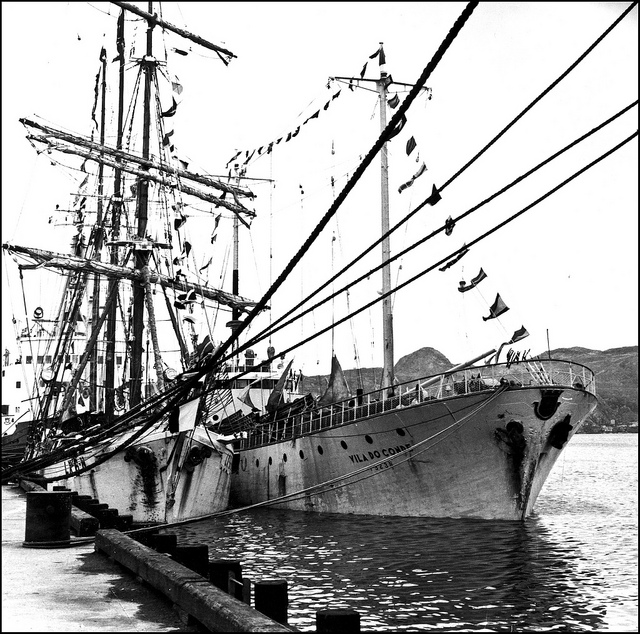The Convention initially allowed for regulatory measures pertaining to: a) establishing closed seasons; b) closure of spawning areas or; c) areas populated by small or immature fish; d) establishing fish size limits; e) prohibiting the use of certain fishing gear and appliances; f) prescribing an overall catch limit for any species of fish.
The species groups initially designated for management were cod-like fish, flatfishes and redfish, extended to other species in subsequent years. The first regulatory action by ICNAF in 1952 was an enforced mandatory minimum mesh size of 4½ inches for haddock. During the next 15 years, ICNAF management actions were limited to regulating mesh size. By the early-1970s, a 130 mm standard was applied in all areas.
In 1968, ICNAF adopted the NEAFC inspection scheme thus harmonizing inspection processes pertaining to gear regulations in the north Atlantic. The Standing Committee on International Control (STACTIC) was established in 1971. That committee was tasked with all aspects under the Scheme for Joint International Enforcement of the Fishery Regulations. In the same year, the Scheme for Joint International Enforcement of the Fishery Regulations became operative, providing for inspectors to examine catches as well as fishing gear.
In addressing the Commission in 1954, Dr. G. L. Kesteven, of FAO expressed a point of view common to the time, the need to increase world production to feed a rapidly growing human population. Sustainability played no part in his address. Economic benefit and not fishery conservation was the focus of the time.
However, that point of view, the need to “yield more food” changed as the consequences of unrestrained fishing became apparent. In 1968, catches in the Convention area peaked at 4.5 million tonnes then declined rapidly as catch rates dropped, the result of declining populations.

While FAO (1960) supported the concept of effort limitation as a way to reduce over-exploitation, ICNAF took a different approach - limiting catches. Advice to the Commission was expressed as follows: “For many if not most of the stocks of major importance the amount of fishing has now reached a level such that further increase in fishing will bring little or no increase in catch, and may even reduce the catch. There must therefore be some direct control of the amount of fishing. All methods of doing this raise difficulties, but that presenting least difficulties is by means of catch quotas”. Based on wide recognition that current management measures were insufficient, the Commission asked STACRES to review various options for resource conservation.
In 1967, the Commission established a Standing Committee on Regulatory Measures (STACREM) to examine the economic, administrative and scientific aspects of proposed regulatory measures (ICNAF 1968). The first task was to determine what research was required to determine appropriate quota levels.
The first measures to control catches, and hence the level of fishing mortality, were agreed to in 1969 for application in 1970. The Convention was amended in 1971 to allow for national allocation of catch quotas which paved the way for acceptance of a catch quota control scheme. The task of allocating the quota was done by STACREM. It was stated that “the shares should be based mainly on historical performance but should also take account of other factors, such as provision for states with developing fisheries, coastal states, and states with fleets which are incapable of being diverted to other fisheries”. The process was in the form of negotiations.
Haddock was the first to be placed under Total Allowable Catch (TAC) controls, followed yellowtail flounder in 1971, herring and cod in 1972, silver hake, American plaice, pollock, mackerel and redfish in 1973 (Table 3). By 1974, virtually all stocks subjected to a significant directed fishery were under TAC control including the newly established deep water fisheries.
"Second tier" TACs were also established in 1974, set at a level below the sum of the first tier TACs to address mixed fishery and by-catch problems and to allow for species interactions.
Other regulatory measures put in place by ICNAF included minimum fish size (kept), closed areas and seasons and fishing effort restrictions. However no other measures were as effective in reducing pressure on the stocks as quota regulation.
Also, in the 1960s, the Council of Europe called for a ban on high-seas drift netting. In 1972, ICNAF members agreed to cease the fishery beyond 12 miles thus shutting down a harmful fishery. Drift netting persisted long after in other parts of the world.
By 1976, vessels of at least five non-member countries were known to fish in the Convention Area. Efforts were made (unsuccessfully) to obtain the cooperation of those countries in providing details of their fishing activities. Catches taken by such means were unrestricted and undocumented adding to the problem of trying to manage the fisheries at a sustainable level. This fishing by non-Contracting Parties was later deemed illegal. The problem became global in later years and was referred to as IUU (Illegal, Unreported and Unregulated) fishing.
In terms of ICNAF as a fisheries regulatory instrument, ICNAF was at the forefront, the first to establish control of level of exploitation, to adopt TAC regulations, national allocation of catch, and in the case of second tier TACs, the first to attempt multispecies management. Unfortunately, for many stocks, catch controls came too late and in retrospect were not great enough. Increased fishing mortality eventually contributed to the collapse of many commercial stocks.